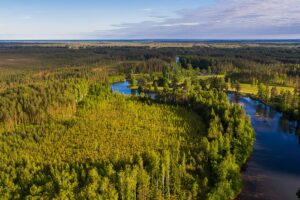Every year more investors turn to real estate as a way to diversify their retirement portfolios. Everything from pre-construction, condominiums, and rental properties to rehabs, lease options, and raw land are held inside of tax-advantaged IRAs and 401(k) plans. With (typically) annually growing contribution limits and over 3 trillion dollars currently held in retirement plans across the country, investors are now able to look beyond the realm of stocks and mutual funds to assets like real property.
Though investors continue to become more sophisticated in their real estate transactions, undeveloped land remains a favorite among IRA investors for a few reasons. One of the main appeals is the simplicity with which raw land provides investors the opportunity to diversify into real estate, without the headaches of property upkeep.
An obvious upside to purchasing raw land with a retirement plan is diversification. Alternative assets such as real estate have long provided investors a way to offset fluctuations in the securities market. Over the years, millions of investors have utilized diversification strategies in their personal portfolios. Only recently have investors begun prioritizing diversification within their retirement plans.
One of the reasons why less than 3% of all retirement funds are currently invested in real property is the fear that managing the asset is a difficult or time-consuming process. An attractive attribute of raw land is its simplicity. Land provides retirement investors with opportunity to participate in the real estate market without the consideration of upkeep or unforeseen expenses for the property.
Keep in mind, when a retirement plan holds a piece of real property, all the expenses involved must be paid for by the plan. If an IRA owns a rental property, then the IRA must pay for all of the repair and upkeep of that unit. Investors who self-direct their retirement plans to purchase assets like real estate will have to be more involved than those who simply invest in stocks and bonds.
Raw land offers retirement investors a low-maintenance way to participate in real estate. Annual property taxes are one relatively predictable expense of raw land. If an investor chooses to lease out their land to a farmer or a timber company, then there may be additional expenses in that scenario. However, for most parcels of land, property taxes are the only expense. An investor can diversify part of their retirement portfolio by purchasing a parcel of a land, and not have to worry about any unexpected repairs or costs that accompany rental properties.
Any economist or financial advisor will say that appreciation is driven by supply and demand. The simple truth about land is that there is only so much. The supply is somewhat fixed, especially when it comes to desired land around mountains, waterways, and growing metropolitan areas.
When it comes to diversifying a retirement portfolio, raw land is about as close to a mutual fund as an investor will get. Raw land is an asset that can be purchased and held for the long term, without the worry of unexpected repairs or expenses. Whether it’s a lot in a planned development near Destin, Florida, or a large track of farmland outside of Topeka, Kansas, land provides a simple way to diversify a stock-heavy portfolio.
Written by Patty McCrystal, Content Editor for New Direction IRA
This content may not be used or reproduced in any manner whatsoever, in part or in whole, without written permission of LANDTHINK. Use of this content without permission is a violation of federal copyright law. The articles, posts, comments, opinions and information provided by LANDTHINK are for informational and research purposes only and DOES NOT substitute or coincide with the advice of an attorney, accountant, real estate broker or any other licensed real estate professional. LANDTHINK strongly advises visitors and readers to seek their own professional guidance and advice related to buying, investing in or selling real estate.










There is an easier way. Buy property outside of your retirement plan. When you sell, we can defer the capital gains tax, state tax and depreciation recapture on the sales proceeds and provide the seller with a lifetime income.. And the income can be passed on to the heirs.
I’m considering both options: buying farmland within solo 401k and outside retirement plan. I would like to know more on both options. Where can I find this info? Who should I talk to?